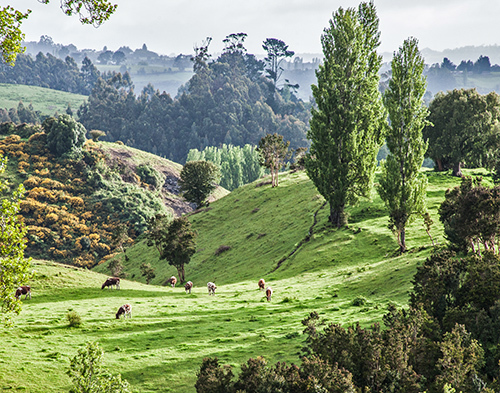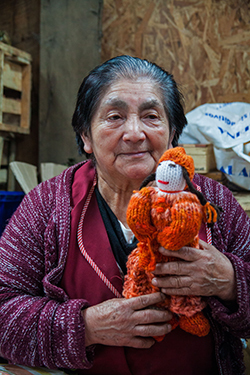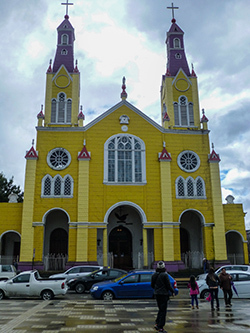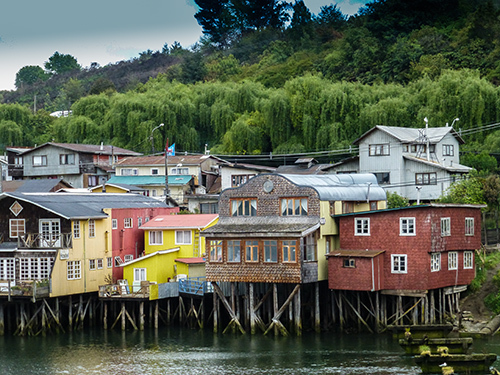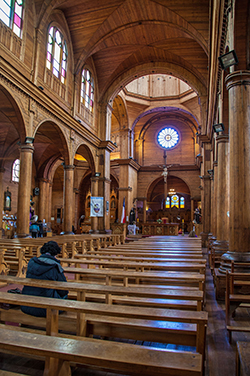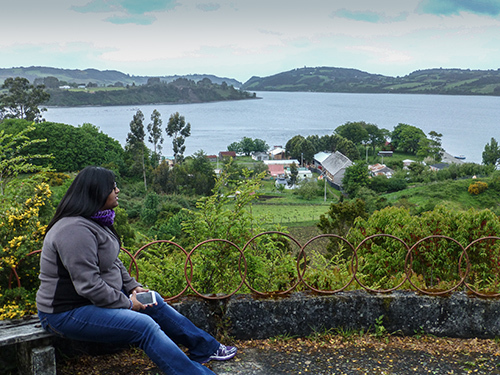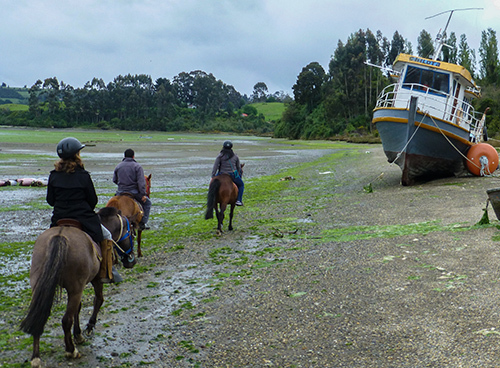Things are seldom what they seem here on the island of Chiloe, in Middle Earth, a cluster of emerald-green hills rising out of the Pacific Ocean. Skim milk doesn't masquerade as cream, exactly, and hobbits are thin on the ground. But as the growing number of foreign travelers touring this 40-island archipelago have discovered, every day brings a new surprise.
The woman selling the orange and pink hand-knit dolls at the farm market in the center of Castro, for example. She's trying to tell me about her wool, I'm trying to answer, and neither of us is connecting. The funny thing is that we're both speaking Spanish, Chile's first language. But we're at an impasse. "She's says the wool comes from her sheep and she spins it herself," says Rodrigo Guridi, a long-time resident and my guide for the day. "You'll have to stay longer if you want to pick up the accent," he says, reminding me that Chiloe's culture isn't like anything else in South America.
For 300 of its early years, Chiloe (CHEE-low-way) was isolated from the mainland, gradually evolving its own lifestyles, traditions, cuisine, farming and fishing styles and even its language. On your next visit, says Guridi, "come in the fall, after summer vacation ends and tourists from Santiago go home." Now he tells me, I'm thinking, wondering what comes next. I wasn't sure what I'd find, not after my two-day stop-over in Santiago, Chile's capital city, with my friend Salina, who said that Chiloe reminded her of "the shire." But I saw what she'd meant when I reached my hotel outside Castro, the Parque Quilquico, built on a bluff, and looked out over the trees toward a long, blue bay.
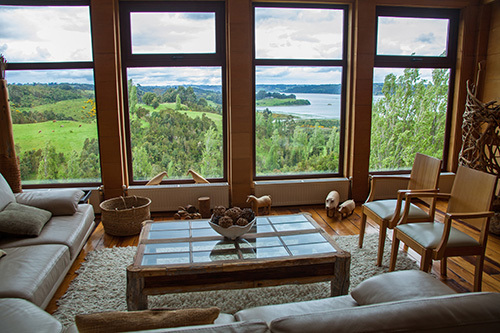
"Oh, take a look! It's breathtaking," gushed the woman who'd shared our cab from the airport. Beyond the windows lay a wonderland of rolling hills, grassy meadows, leafy trees and half-hidden vales sloping down to the sea. A dozen brown and white cows grazed in the foreground, enjoying the last warm days of summer. Only the hobbits were missing. "It's so familiar," she said, sinking down onto the sofa, her expectations ajar. "I know this is Chile, but I feel as if I'm somewhere else, in Vermont or England."
The next morning she and I headed into Castro to the farm market, for some insight on what might appear on our dinner plates. Familiar veggies, fresh cabbage, lettuce, tomatoes, onions, carrots, apples, purple, yellow and white potatoes filled the stalls, along with honey, fresh bread, fish and cheese. The same nubby, raw-spun wool that made my doll reappeared in grey and brown shawls, hats, socks and blankets. But what in heck were those dried brown lumps strung on long cords, the green bricks, the long white stalks and mud-colored leather? I've said yes to some strange edibles in my time -- grilled warthog and seal oil-ice cream among them -- but this food, if it was food, could have been expired army field rations.

These were delectable, as it happened. Smoked, dried sea squirts; two kinds of smoked mussels; the nalca plant stems from the giant Chilean rhubarb; "bricks" of dried seaweed; and dried bull kelp leaves, folded into squares and tied together with the stems. "People stick to the old way of doing things, so nothing is wasted, even seaweed," said Guridi. "If you wanted to survive on this island, you had to be ingenious."
Chiloe isn't that far from the mainland coast; you can see it across the water. But after the first Spanish conquistadors conquered and occupied what is now Peru, they turned south, expecting to extend their rule. But the Mapuche tribes living south of the Bio Bio River were battle-tested warriors. The defeated Spaniards fled north, except for a small group of Spanish and Huilliche settlers, who escaped, crossing over to Chiloe.
Isolated, the new arrivals mixed, blending their traditions and creating today's mostly mestizo population. The only outsiders were a group of Jesuit priests who traveling from one island to the next, converting people and encouraging them to build churches. The Jesuits, volunteers from a half-dozen different European countries, sketched architectural styles they remembered from home: neoclassical, baroque, gothic and others.
"The Jesuits knew what a church should look like, but they didn't know how to build one," said Carlos Miranda, a guide at the Tierra Chiloe Hotel, who leads cultural tours of the islands. "What the people knew how to build was boats," he said, escorting us to the church in Rilan to look at the finel-crafted ceiling, built "exactly like an upside-down boat." Today, 15 of the churches, now designated as World Heritage sites, are Chiloe's most visited attraction.
Chiloe's other signature buildings are the "palafitos," ancient ramshackle wood houses built on stilts built over Castro's bay, apparently to keep them high and dry when the 23-foot high tides flooded the bay. The same tidal variation has created broad estuaries and wetlands along Chiloe's east and west shores, making this one of the world's top birding destinations. Resident and migrant birds include Magellanic and Humboldt penguins, and the Chilean skua, parasitic jaeger, Buller's albatross, kelp goose, cinnamon teal, black-necked swans and Chilean Flamingoes.
Surprisingly, most of Chiloe was glaciated during the last ice age, which when the ice melted left dozens of mountainous moraines, now the island's green hills. But the glaciers stopped short of a narrow coastal strip now protected as Chiloe National Park. We stopped in at the interpretive center, at the park's southern entrance, for an introduction to the flora and fauna that predates the ice. But this ancient forest is so thick and tangled and the ground cover so wet and spongy that most of the park is literally inaccessible. If it weren't for the mile-long boardwalk that looped into and around the forest, we wouldn't have had a clue to the way it was when the glacier entombed the island, nor an answer to another one of Chiloe's many mysteries.
QUICK GUIDE TO CHILOE: Chiloe is a four-season destination. Autumn (March to May) has mild temperatures and off-season rates. Rain falls occasionally; it snows in winter.
LODGING: Hotels, inns and B&Bs are available in most price categories; see www.turismochile.travel. For a fine cuisine and rustic luxury, try the popular Hotel Parque Quilquico (www.hpq.cl). The Tierra Chiloe (www.tierrachiloe.com) provides contemporary luxury in a minimalist setting. Both have excellent ocean views, fine cuisine and room rates with or without meals. Also available are spa services, swimming pool, fitness equipment, guided tours and outdoor recreation and airport transfers.
FLYING THERE: The shortest total airline flights are on LAN from the U.S. to Santiago, with a single stop in Lima, Peru. Other airlines and flight combinations also fly to Santiago, but with more stops and /or longer airport waits.
Photo images by Steve Haggerty/ColorWorld, used by permission.
Got questions? Have something to add? Start a blog topic and I'll answer.
